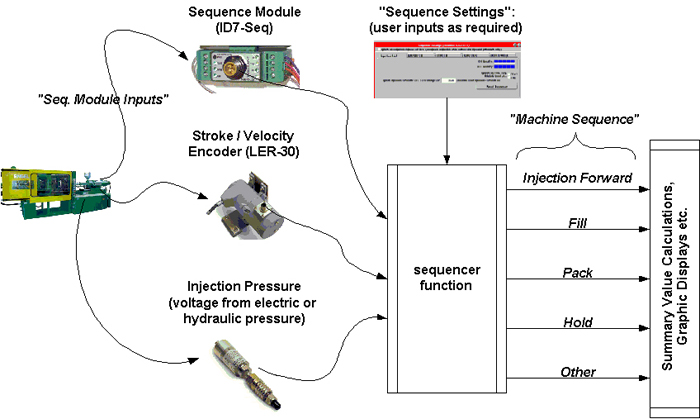Tip of the Day 26: What’s It All About
We are constantly looking for ways to make the eDART easier to hook up to machines. Since this is hard the question is: Why do we have to hook up to the machine at all?
The short answer is this: We could get by with just some signal (such as a mold clamped limit switch) to tell when the cycle starts. But we would be missing much of the information that can be used for analysis, problem solving and higher level part sorting (e.g. cavity fill time). Furthermore, if you want to do analysis and such without hooking to the machine you have manually tell the eDART the information it does not have because of the missing inputs. This step often gets forgotten or messed up so the eDART cannot calculate things properly.
Nevertheless, the eDART is supposed to “work” in the case where not all signals are available. Internally it MUST have some sort of signals in order to at least cycle. And those signals must have stable names so that all of the different software that does calculations knows what to expect. So the eDART takes in all of the information it is given and tries to figure out what the machine is doing. What the eDART thinks the machine is doing is represented by the signals named “Machine Sequence”.
The diagram below summarizes this.

The eDART’s “sequencer function” (“sequencer” for short) takes all of the information that it is given and creates the “Machine Sequence” signals that are used by the rest of the software. In the process it tries to ignore or clean up strange events in the raw “Seq. Module Inputs” such as double on/off events per cycle.
If you provide all of the recommended signals (Inj. Pressure, Stroke / Velocity, Inj. Fwd, Screw Run, Mold Clamped, Mold Opening and Machine in Manual) then the sequencer function has little work to do in order to create the “Machine Sequence” signals. If you do not hook up all of the signals then one of two things will happen:
- The user needs to supply some of the missing information
- Some of the Machine Sequence signals cannot be created.
In (1) the user may not enter the information or may enter it incorrectly. If he does then the Machine Sequence signals may go on and off at the wrong times causing improper calculation of values.
In (2) some of the summary values may not get computed. This will reduce the amount of information available to help solve problems. For example, if injection pressure is not connected you cannot see changes in material viscosity. If the information is not needed then you can get by without the sequence signals. If some sequence information is available on one machine and missing on another then customers may wonder why they get different results on each.
Why all this complexity?
Sorry. That’s the way it is. Today.
Historically it came from the days of DARTs. As we learned more about sequence hookups we found that you could figure out more exactly what was happening to the plastic – The “Four Plastics Variables”. Also we learned that you could not always get some signals from the machines and some that you could find were not the best quality.
So the design above was created to clean things up and provide information for more in-depth analysis of the process. As we have developed lower cost systems such as the eDART flx™ we have removed some of the need for sequence signals. Correspondingly these systems cost less because they do not provide as much analytical power as does the full eDART. Yet the sequencer still helps clean up signals and create enough information for the limited needs of the lower cost system.
This is intended as an introduction to the theory of sequencing. In subsequent tips I will cover each signal in more detail.